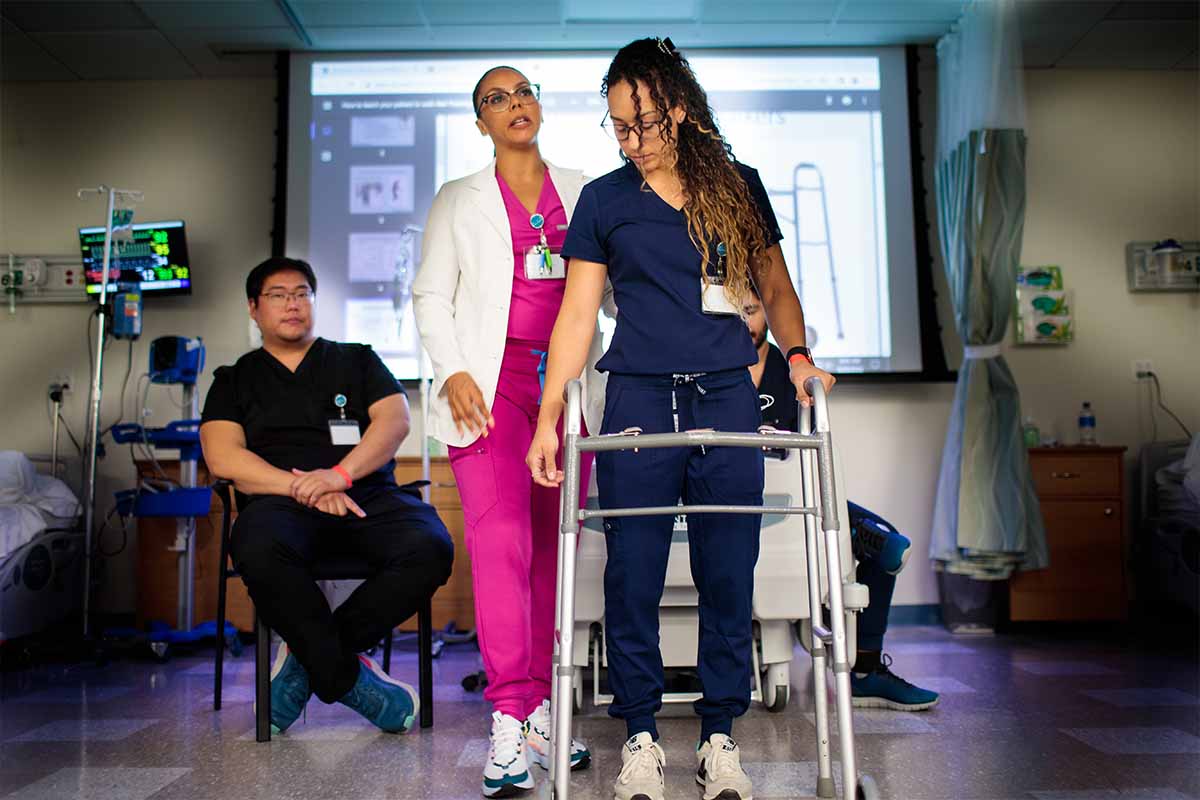
A Doctor of Occupational Therapy (OTD) degree enables healthcare professionals to assist clients in a variety of ways, from helping seniors learn how to mitigate falls in their homes to promoting the physical mobility of employees who have been injured in the workplace.1
Occupational therapists (OTs) also enjoy a rewarding professional experience: The U.S. Bureau of Labor Statistics (BLS) reports that occupational therapists earn a median annual income of $85,570—nearly double the median salary across occupations in the United States.2,3
If you’ve started to explore occupational therapy as a career path, you may have questions about how to find a role in this promising field. What is an occupational therapy degree, and what are the educational options for future OTs?
What is an OTD Degree? Discover the Basics.
If you’re planning to pursue an OT career in the U.S., successful completion of an OTD or a Master of Occupational Therapy (MOT) degree from an accredited program is required to practice.5
Typically, an OTD program requires two to three years to complete and includes:2
- Didactic learning
- Clinical training
- Supervised fieldwork
- Capstone project
An OTD degree will prepare you with the skills to work with clients and:7
- Perform patient evaluations
- Establish and modify treatment plans
- Provide treatments
- Evaluate and document patient progress
- Discharge clients
- Conduct independent research
- Pursue advocacy and leadership roles
An OTD program typically culminates in a doctoral capstone project, which allows OTD candidates to select a specialty of their choosing and examine it in depth. The capstone process strengthens independent research skills and allows for the art of collaboration.
Following completion of an occupational therapy degree and licensure, OTDs may have the opportunity to work not only in hands-on, clinical settings—such as nursing homes, pediatric clinics, and mental health facilities—but also in the following roles:
- Clinical research
- Higher education
- Leadership
- Advocacy for special populations
What is the Difference Between an MOT and an OTD?
The difference between MOT and OTD degrees is largely self-explanatory: the OTD is a more advanced degree.
The primary differences between an MOT and an OTD are:
- Duration – A master’s degree, in any field, generally requires less time than a doctoral program. An MOT takes approximately eight months less than an OTD.
- Doctoral capstone – Doctoral candidates are required to complete an experiential capstone project. Candidates explore a topic of interest, from better understanding the impact of isolation on seniors to helping wounded veterans reenter the workforce.
- Different outcomes – An OTD candidate receives a similar education to an MOT candidate; however, an OTD candidate’s capstone project gives them and real-world exposure to important topics of interest, and sets the stage for roles in leadership and advocacy.7
The return on investment between the two degrees is higher for MOTs, because they can begin work and earn sooner, and may pay less for their occupational therapy education. 7 However, an OTD may have more professional opportunities in the long run.7 MOTs can always decide later to pursue an OTD.
No matter if you choose an MOT or an OTD, all occupational therapists must pass the national examination for licensure, administered by the National Board for Certification in Occupational Therapy (NBCOT).2
Following licensure, OTs officially become OTRs (registered occupational therapists).9
While requirements vary by state, OTs are generally required to continue their education to maintain their license.10


2022 images
What is the Difference Between an OTD Degree and a Post-Professional OTD Degree?
Both OTDs and PPOTDs are equipped with the education and training to assume leadership, advocacy and teaching roles.4
A PPOTD program is a potential path for practicing occupational therapists who want to advance their careers, while OTD degrees are considered an entry-level program that allows graduates to immediately enter the workforce.4
What are the Admission Requirements for OTD Programs?
OT school requirements for OTD programs vary depending on the institution. They typically require:
- A bachelor’s degree from an accredited institution, typically science-focused, such as physiology or biology2
- Official transcripts issued by your undergraduate institution11
- Letters of recommendation11
- Statement of purpose11
- Curriculum vitae/Resume11
- Completion of prerequisites11
- Personal essay11
- Observation hours11
Why Should You Pursue an OTD?
An OTD is a significant investment—of your time, energy, money and other resources. Yet, the benefits of an OTD are incredible. Let’s review a few of the most appealing:
- Excellent earning potential – OTs stand to earn a robust salary—approximately $85K per year, depending on geographic location and the type of facility.2,12 In a few states, it’s possible that OTDs may earn up to $100,000 or more, paving the way for comfortable and enjoyable lives.12
- Job security, resilience and growth – From the pandemic’s high levels of unemployment to the emergence of AI, individuals have become concerned about the future of their careers.13However, the U.S. Bureau of Labor Statistics anticipates that the field of occupational therapy will grow by 14% in the next eight years, which is substantially faster than other occupations. 2
About 10,000 OT jobs are expected to open up each year over the course of the next decade, potentially broadening your opportunities and giving you greater autonomy for where to work—both in geographic location and facility.2
- Enhanced opportunities – An MOT graduate may work primarily, if not exclusively, in a clinical setting, an OTD may have the opportunity to find employment in additional areas of practice, such as:7
- Theory
- Program development
- Research leadership
- Emerging practice areas
Is an OTD Right For You?
Occupational Therapists typically have profound wells of compassion, as well as the capacity to work with a vast range of individuals of every age.1
A few desirable qualities in an OT include:
- Empathy – Imagine needing to relearn skills after a stroke or dealing with a catastrophic injury that has left you paralyzed. You may feel vulnerable, afraid and sensitive. The preferred OT would express empathy throughout the process so that you might feel secure and confident. OTs who embody this characteristic may have a higher success rate with their clients —and see more positive outcomes.14
- Flexibility – In clinical settings and beyond, OTs work with a range of individuals and injuries, illnesses and circumstances.15 The ability to adapt one’s therapeutic approach, recommendations and more is therefore crucial in this role.
- Interpersonal and communication skills – An open line of communication between an OT and their clients is key to successful results and patient satisfaction.16 Interpersonal skills help to build trust and confidence between you and your clients—as well as their medical teams and loved ones—and can contribute to healing and recovery.
Many prospective OTs possess these innate but underdeveloped traits. Education and experience help them to hone these skills.
However, only you can determine if OT is an enticing career path for you. Do you take pride in helping others progress? Are you fascinated by anatomy and the abilities of the human mind and body? Do you enjoy working with a variety of personalities and backgrounds? If so, you might consider becoming an OT.

Is an OTD or MOT the Only Path to Become an Occupational Therapist?
Yes, but becoming a registered OT isn’t the only way to work in the field.5
Some candidates may want to accelerate their academic program and begin working and helping clients. In this case, one might enter an OTA program and become an occupational therapy assistant (OTA). This requires:5
- A high school degree, GED, associate degree and/or the equivalent
- Generally, two years of study
If you decide to become an OTA, it could prepare you to later pursue an MOT or OTD.
Fulfill Your Purpose with an OTD Degree
Occupational therapists are an integral part of the healthcare system and have the opportunity to make a significant impact on the lives of their clients. Whether you’re interested in a long career in clinical care or would ultimately like to see yourself in a leadership or advocacy role, an OTD degree can open doors for you.
The University of St. Augustine for Health Sciences offers MOT, OTD and PPOTD programs to help you gain the tools and knowledge you need to thrive as on OT. With a flexible curriculum and residential and in-person learning, expert faculty, innovative learning models and state-of-the-art technology, we help you deliver on your dreams.
Request information about our OT programs and apply now to launch a rewarding OT career.
Salary data may not reflect starting pay for recent graduates.
Sources:
- American Occupational Therapy Association, Inc., “What is Occupational Therapy?”, AOTA, last modified 2023, https://www.aota.org/about/what-is-ot
- U.S. Bureau of Labor Statistics, “Occupational Therapists: Occupational Outlook Handbook,” U.S. Bureau of Labor Statistics, last modified September 2022, https://www.bls.gov/ooh/healthcare/occupational-therapists.htm
- USA Facts, “Median Annual Wage,” USA Facts, last modified 2023, https://usafacts.org/data/topics/economy/jobs-and-income/jobs-and-wages/median-annual-wage/
- K Hoyt and S Lyon, “Which OT Degree? (OT, OTD, PPOTD & More!),” OT Potential/Occupational Therapy Resources, last modified August 2022, https://otpotential.com/blog/occupational-therapy-degree
- American Occupational Therapy Association, Inc., “Program Admissions and Formats,” AOTA, last modified 2023, https://www.aota.org/career/become-an-ot-ota/start-your-career-journey/program-admissions-and-formats
- University of St. Augustine for Health Services, “How to Become an Occupational Therapist Benefits & Job Opportunities,” USAHS, https://www.usa.edu/blog/how-to-become-an-occupational-therapist/
- University of St. Augustine for Health Services, “MOT and OTD Degree Program Comparison,” USAHS, https://www.usa.edu/college-of-rehabilitative-sciences/doctor-occupational-therapy/#otd-residential-flex-comparison
- University of St. Augustine for Health Services, “Breaking Down the OTD Capstone Process,” USAHS, last modified May 2021, https://www.usa.edu/blog/breaking-down-the-otd-capstone-process/
- S Stromsdorfer, “Steps to Get Your Occupational Therapy License State by State,” My OT Spot, last modified 2021,https://www.myotspot.com/occupational-therapy-license/
- AOTA, “Occupational Therapy Profession–Continuing Competence Requirements,” AOTA, last modified May 2022, https://www.aota.org/-/media/corporate/files/advocacy/licensure/stateregs/contcomp/continuing-competence-chart-summary.pdf
- University of St. Augustine for Health Services, “Doctor of Occupational Therapy (OTD) Degree,” USAHS, last modified 2023, https://www.usa.edu/college-of-rehabilitative-sciences/doctor-occupational-therapy/
- U.S. Bureau of Labor Statistics, “Occupational Employment and Wages, May 2021,” U.S. Bureau of Labor Statistics, last modified March 2022, https://www.bls.gov/oes/current/oes291122.htm#st
- A Semuels, “Millions of Americans Have Lost Their Jobs in the Pandemic—And Robots and AI Are Replacing Them Faster Than Ever,” Time, last modified August 2020, https://time.com/5876604/machines-jobs-coronavirus/
- J Walker, “The Power of Empathy in Healthcare,” AAPA, last modified December 2022, https://www.aapa.org/news-central/2020/04/the-power-of-empathy-in-healthcare/
- R Olivera, “The Relationship Between Mental Health and Occupational Therapy,” Simple Practice, last modified March 2021, https://www.simplepractice.com/blog/mental-health-and-occupational-therapy/
- T Brown, M Yu and J Etherington, “Are Listening and Interpersonal Communication Skills Predictive of Professionalism in Undergraduate Occupational Therapy Students?”, Science Direct, last modified June 2020, https://www.sciencedirect.com/science/article/pii/S2452301120300158









